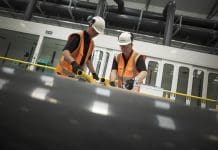BAM’s UK & Ireland businesses have set an ambitious carbon target to become net zero by 2026 in their direct operations
BAM’s UK & Ireland businesses will be operating at net zero by 2026, according to new carbon targets announced today (3rd October).
The target, excluding counting electricity from green energy tariffs towards its net zero emissions, builds upon Royal BAM Group’s aim to reduce its direct emissions intensity by 80% by 2026 from 2015 levels.
Its Science Based Target requires a 50% reduction by 2030, but it expects to meet this seven years early.
The CDP has ranked BAM as an ‘A’ list company for the past 5 years.
This is a radical move within the construction sector to achieve net zero
In a statement of transparency, BAM is not relying on carbon offsets to account for its sustainability goals, as they believe it can disguise more substantial progress.
John Wilkinson, chief operating officer of BAM UK & Ireland, said: “There is no room for or advantage in disguising or hiding performance. Vague data is useless, so science based, transparent information and a healthy dose of honesty are part of the medicine.
“The other red herring is offsetting. We cannot rely on planting trees elsewhere in the world to cover up our own emissions. Although these have a role to play in the short term, we must drive these down ourselves and face up to our responsibilities.”
The target will take the extra step of taking ownership of scope 3 emissions
BAM’s UK & Ireland net zero commitment encompasses not just direct scope 1 and scope 2 emissions, which are associated with fuels and energy use, but also select scope 3 emissions, going further than most net zero carbon targets in the sector.
BAM’s scope 3 emissions include water consumption, staff transport (across road, rail and air), emissions arising from using hotels, emissions from third party fuel and energy use and all well-to-tank (upstream) emissions associated with scope 1 and scope 2 emissions.
The company says it has significant influence over all these emissions sources.
They become the only company in the sector at present not to count its purchase of renewable electricity towards zero emissions
BAM has chosen to use location-based emissions (the true emissions of the energy used at the plug) as part of its direct scope 2 emissions inventory.
The vast majority of the company’s direct energy procurement already uses REGO-backed energy contracts (Renewable Energy Guarantee of origin certificates issues by Ofgem on behalf of the UK Government) and whilst it could use these to claim that it is zero carbon, BAM believes that it should seek to reduce the real emissions from grid electricity usage.
Any remaining emissions from 2026 will be offset using high quality nature-based solutions such as re-forestation, or carbon capture technologies.
BAM hopes the target of net zero by 2026 will encourage the whole industry to take similar action
John Wilkinson continued: “Net zero carbon is the objective we are all seeking because the construction sector still accounts for 39% of all global emissions. We have a serious job on our hands to get that down and to do so fast.
“That’s why we have chosen to accelerate our progress – and we are not fooled that we will be alone. The whole industry needs to challenge itself, work together, and assist its clients and supply chain to make faster progress too.
“I believe BAM is now firmly at the forefront of our industry but it is the sort of arms race we need to collectively bring about change and decarbonise our environment.”
BAM is supporting the drive towards building more renewable energy generation through the delivery of schemes such as the SSE substations framework in Scotland which directly links to renewable generation.
BAM’s Carbon Reduction lead, Sarah Jolliffe, added:
“We are on a journey here – we have already reduced our emissions intensity by 20% this year compared to the same period last year, mitigating the release of 7 kilotons of carbon.
“We have worked with the Carbon Trust on measuring scope 3 emissions and our FM business has helped pioneer Scope 3 measurement in the facilities management sector working with the SFMI (The Sustainable FM Index). These kinds of collaborations are crucial as we explore more ways to work with our supply chain and clients to decarbonise the built environment.
“The data baseline this has created and our investment in data collection and analysis is a key enabler in confidently setting this new demanding 2026 target.”

















